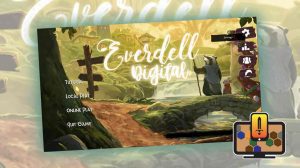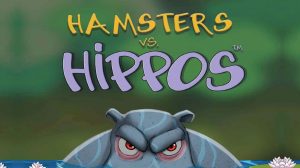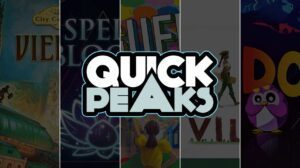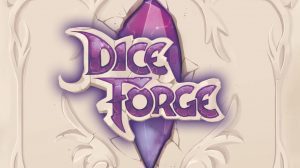Disclosure: Meeple Mountain received a free copy of this product in exchange for an honest, unbiased review. This review is not intended to be an endorsement.
When Greater Than Games Kickstarted a second printing of Compounded (called the Peer Reviewed Edition—stay tuned for our review), they developed a roll & write companion called Lab Notes. I was pretty excited to get my hands on both. Compounded holds a special place in my gaming heart, and we are definitely a scientific gaming family. First up, Lab Notes.
Putting it all together
The core progression is easy and familiar to the roll and write genre. Each player selects one die, with the spare then becoming the shared community die. Players write their elements onto their sheets in any location, bonding the elements together as desired.
The extras also make sense. There is a trash bin for unwanted dice that occasionally triggers an ambivalent effect. Player tools—earned by creating simple compounds—allow for rule-breaking, and as compounds are finished, the capacity for using said tools increases.

The lurking bêtes noires are reasonable. In the sliding market of compound cards, Lab Fires enter the fray, causing players to burn spots on their sheets unless they have an armed fire suppressant tool to stand in the gap. Bunsen burners appear on dice and in the trash bin, which, if managed, provide a free element as they burn a space.
The covalent bonding mechanism is accurate. Carbon, when bonded correctly, forms four covalent bonds. Nitrogen forms three, Oxygen two, and Hydrogen one. In order for a compound to score, each element must have its proper number of bonds. Apart from the restriction against one carbon quadruple-bonding to another, players have absolute freedom to form bonds in the correct numbers as they go. Finishing the suggested compound cards progresses the market and scores bonus points, but really the imagination is free to rule the day.
Electron thoughts
Despite all of this inherent easiness, there is a wrench in the works, a contaminant in the mix, so to speak. The absolute freedom in chemical creation is wholly unsettling for two reasons. First, the rules do not forbid combinations unlikely or impossible in nature. After my first play, I went looking for some of my creations only to find that they just can’t exist. Chemical composition is more than bond-counting, and my effort (despite my victory) felt disingenuous.

Buttressing this issue, Nitrosyl Cyanide, CN2O, describes its strong angles on the card, one at 113°, the other at 170°. On paper, though, it’s a non-issue. Just draw that thing any which way you can.
The second reason is really an extension of the first. The freedom to create anything is largely necessary as the number of available spaces dwindles and the possibility of creating according to the cards diminishes. But I would imagine this aspect to be strangely intimidating to those of us without a bank of chemical structures in our minds. If this were themed abstractly—for it is, at the end of the day, an abstract—I wouldn’t be troubled by the liberty. But because I am purporting to create real compounds with real elements, I feel a completely natural pressure to drop abstraction and create real things. This is the split personality of Lab Notes.
If triangles required three bonds, stars two, etc., I would relish the chance to create boldly absurd chains. Neither do I think I would be bothered by the need to bond as I lay elements. In fact, I would probably try to create a singular structure across all 53 spaces. But replace triangles with “Nitrogen,” and the desire crumbles for me. Maybe it’s just me. I hope it’s just me.
I’ve been trying to devise a solution, but I don’t think there is one in the box. The tool cards require simple compounds. During setup, each player receives a matching trio of tools—one each a solid, liquid, and gas. I think my comfort would be found in a slew of these small compound cards. Maybe sacrificing all that freedom in favor of a grid of nine minis in each play would solve the issue. There would still be ample opportunity for the little fillers when the late-game requires, and even a chance for set collection in rows and columns throughout the game. Plus, I could play without the worry that I’m violating nature. But as this idea grows, I worry about needing different cards, more cards, probably another element, and, therefore, another die, etc., etc.
As it is, though, all I can say is that I’m not comfortable. There’s really nothing wrong with the game’s mechanics. I love the theme—the nerdiness of it all is why I wanted to play—but not necessarily the atmosphere around the theme.
Proton thoughts
Like many in the roll & write genre, Lab Notes starts out rather breezy and ramps up the pressure as the space becomes limited. The covalent bond mechanism is a fantastic way to ponder connections and to place elements with wishful optimism, hoping the right elements will pop up at the right time. I’m reminded of the sort of desperate wishing that makes the end of On Tour so miserably enjoyable.
I do appreciate the sliding card market. When a compound is complete, the card won’t necessarily disappear right away. Instead, the final card falls off the edge and the whole assembly slides. Of course, early completion grants a better score, but it’s nice to know your work won’t be left in the cold because someone else finishes first. This mechanism alone helps to stave off some of the discomfort of coming up with cardless, imaginative combinations.

The community die provides the rest of the tension, enlivens the trash heap, and forces some interesting decisions. When the bunsen burner is willingly taken, it holds both its blessing and its curse. But if it lingers to become the community die, it’s all hurt as the fire grows out of control. This means someone should take the thing early to save the group. Right? There’s a very light tension here, but it works.
Neutron conclusion
I’m guessing Lab Notes will resonate with some as is. I think a few modifications would make it far more appealing. Science games are tricky. There are folks who tune out at the mention of covalent bonds, so I understand the desire to keep it simple. But a game like this could really shine with a hint of added complexity in the name of fidelity and clarity. The base audience for this title would definitely celebrate the decision, and a number of others might find it easier to learn with proper rails, even if the rails walk up a bit of a ramp.












When I was in college, I had a Chemistry Professor who had created a game similar to this. It used cards and had rules that prohibited things that did not exist in nature. It was primarily a game he used to give to students to use as a study aid — create the compound and tell your opponent the name of that compound. That last part was important to the scoring and such.
It was a good game, and I helped him reach out to a few game companies to see if anyone was interested. Unfortunately, nobody was. 🙁
Anyway, I hope there is an expansion or something that will make this game more scientifically accurate. Until then, I will just play what I have.
I am amazed at how much the game already does mirror reality. It’s definitely a nitpick on my part to demand more; and yet, I cannot shake that funny feeling as I play that I can bend nature ever so slightly in my favor. I can’t wait to see the consensus opinion on the title.
(I am thankful for teachers who successfully gamify the classroom. There are so many students who benefit from that sort of creative interaction.)